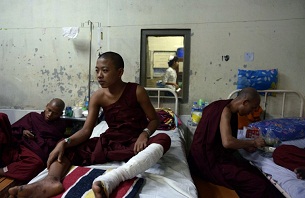Burma: Chemical used in crackdown: probe
| Publisher | Radio Free Asia |
| Publication Date | 31 January 2013 |
| Cite as | Radio Free Asia, Burma: Chemical used in crackdown: probe, 31 January 2013, available at: https://www.refworld.org/docid/511ce45114.html [accessed 1 June 2023] |
| Disclaimer | This is not a UNHCR publication. UNHCR is not responsible for, nor does it necessarily endorse, its content. Any views expressed are solely those of the author or publisher and do not necessarily reflect those of UNHCR, the United Nations or its Member States. |
2013-01-31
A Burmese lawyers' network says canisters thrown at copper mine protesters contained white phosphorous.
 Monks injured in the crackdown on the copper mine protests rest at a hospital in Mandalay on Dec. 3, 2012. AFP
Monks injured in the crackdown on the copper mine protests rest at a hospital in Mandalay on Dec. 3, 2012. AFP
Investigations into a crackdown on protests against a Chinese-backed copper mine in northern Burma have revealed that police used white phosphorous – a highly flammable chemical – to disperse the crowd, in defiance of international law, a legal group said Thursday.
Lab tests showed that canisters police had shot into the crowds at the Letpadaung copper mine in Sagaing division in November contained the chemical, the Upper Burma Lawyers' Network said.
More than 100 protesters, nearly all of them monks, were injured in the raid, the toughest crackdown on demonstrators since President Thein Sein's reformist government came to power in March 2011.
"We gave the materials, including the canisters and burned robes of monks which were given by local people to PLS, an Australian laboratory based in Bangkok," the head of the network's legal committee Thein Than Oo told RFA's Burmese Service.
"The laboratory results shows that the canisters contained 25 percent white phosphorous," he said.
White phosphorous is normally reserved for military purposes, as a smoke screen or an incendiary weapon.
Burns sustained by monks and protesters during the crackdown had prompted a national outcry in the Buddhist-majority country.
Thein Than Oo said the legal group had sent their findings to the official government commission set up to investigate the mining project.
Led by opposition leader Aung San Suu Kyi, the commission tasked with making recommendations on the future of the controversial copper mining project is set to complete its investigation Thursday.
"We informed the inquiry commission led by Daw Aung San Suu Kyi of what we found via email," Thein Than Oo said.
"We are waiting for the legal report from the inquiry commission. When the legal report of the commission is released, we will release our report in English and in Burmese."
International law
Thein Than Oo said the burns sustained by protesters indicated the materials used were in violation of international law.
"The injuries that people and monks got from the crackdown were burns."
"Protocol 3 of the U.N. Convention on Chemical Weapons says any weapon that can cause burns is forbidden [to use on civilians]. Whether it's a bullet or a bomb or a rocket, anything that produces flames cannot be used," he said.
Thein Than Oo said the group had collected canisters used at the site from activists and had worked with an American human rights lawyer, Roger Normand, to get the materials tested in Thailand.
"[Normand] met with the local activists Ma Aye Net, Thwe Thwe Win, and Phyu Phyu Win from the Letpadaung copper mine area and they gave him the materials, including a metal canister that protesters said was fired by the police."
Normand also met with injured monks and people at Mandalay Public Hospital and plans to meet with Ashin Tikhanyana, a monk being treated in Bangkok for severe burns sustained during the crackdown, he said.
On Tuesday, some 2,000 Letpadaung villagers staged a protest march in the area calling for action against the authorities responsible for the crackdown and the release of activists detained during the protest.
The mining project is operated by Wan Bao Co. – a subsidiary of state-owned Chinese arms manufacturer North China Industries Corp. (Norinco), which jointly owns the project with the Burmese military's Union of Myanmar Economic Holding Ltd.
Letpadaung villagers have said that they do not want pollution from the mine to destroy the area and that authorities had confiscated farmland from to make way for the mine.
Thein Than Oo said that aside from the burns, the lawyers' group would be examining other legal issues related to the protest and crackdown.
"We will discuss other legal problems, such as whether the contract between Wan Bao Company and the state is legal, whether the authorities' crackdown was in accordance with international law, whether the protest constitutes an unlawful assembly, and whether the Section 18 [of the Peaceful Assembly Law] that was the grounds for refusing the peaceful gathering in a public area is harmful to citizen's rights."
Reported by Tin Aung Khine for RFA's Burmese Service. Translated by Khet Mar. Written in English by Rachel Vandenbrink.
Link to original story on RFA website
